Assuming you’re on a Windows 10 workgroup computer that can access an existing domain controller:
1. Run the command sysdm.cpl. This command will open the System Properties control panel applet.
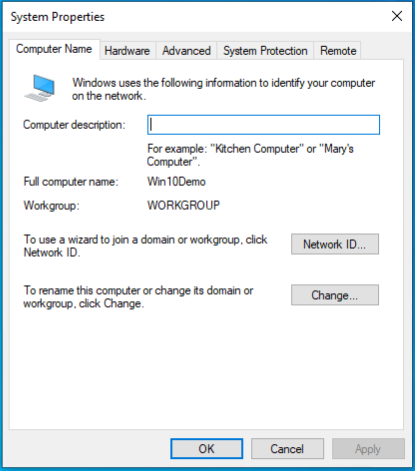
2. On the System Properties screen, click the Change button. This button will bring up the Computer Name/Domain Changes dialog box.
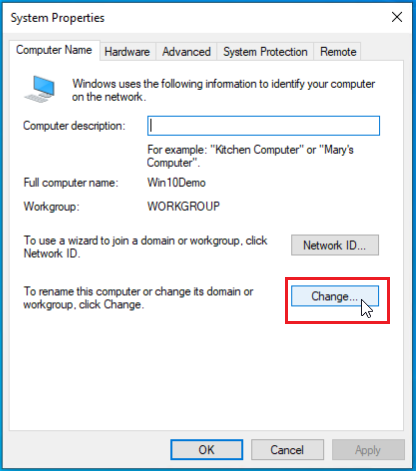
3. You can see below this computer is in a workgroup called WORKGROUP. In the Computer Name/Domain Changes dialog box, click on the Domain radio option to input a domain to add this computer to.
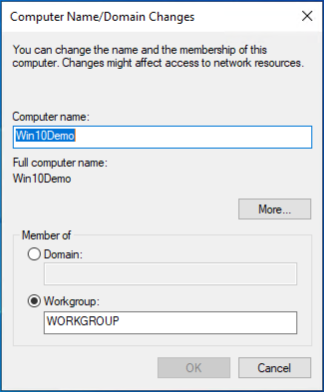
Computer Name/Domain Name Change Dialog box
4. Input the name of the domain to add the computer to in the Domain box and click OK. The computer will then attempt to contact a domain controller and add itself to the domain.

Computer Name/Domain Name Change Dialog box
Related:The Trust Relationship Between This Workstation and the Primary Domain Failed
If your computer is not able to contact the domain name you entered immediately, it throws the below error: If the computer cannot contact a domain controller, ensure the computer’s DNS server points to a domain controller. The computer must be able to find the DNS SRV record to find a domain controller.
5. If the computer can contact a domain controller, it will prompt you for a username and password, as shown below. Input a user account with permissions to add this computer to the domain and click OK.
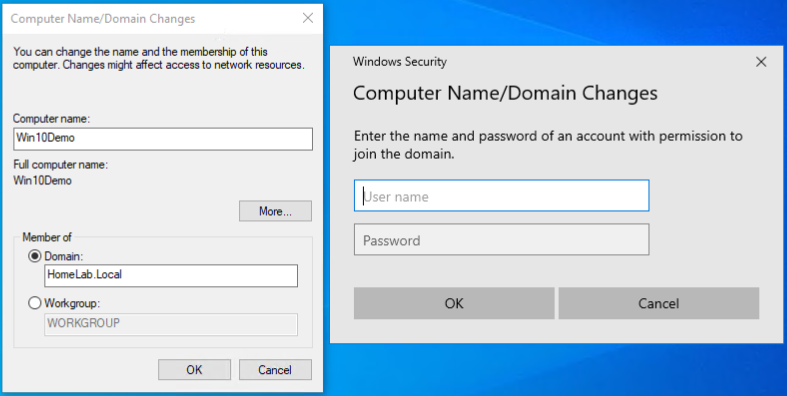
6. If all goes well, you will receive a message welcoming you to the domain as shown below. At this time, the computer creates an AD computer object. Click OK.
Related:Get-ADComputer: Find Computers in OUs in PowerShell

7. Click on OK again to confirm the need to restart the computer.
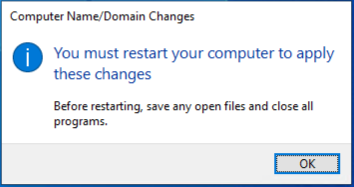
8. You’ll then be redirected back to the System Properties dialog box, but now you will see a warning (Changes will take effect after you restart this computer.) Click on Close.
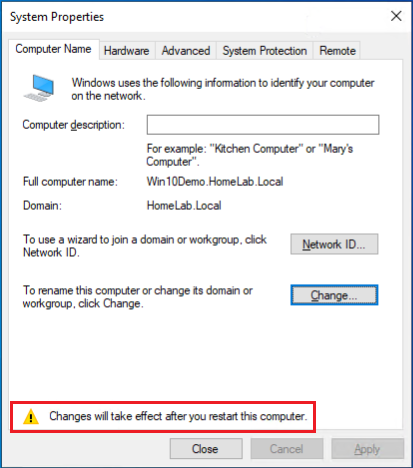
9. Once you click on Close, Windows will prompt you to restart now. Click on Restart now to restart the computer immediately.

Adding a Local Computer to a Domain via Settings app
Steps explained below are only available in Windows10 20H2 version. These steps may change in future windows10 versions.
1. Right click on start menu and click settings.

2. Under settings, click on accounts

3. In the next page, click on “Access Work or School” option and click on connect option to the right.

4. As we are going to join this machine to local Active Directory Domain, in the Microsoft account dialog box, click “Join this device to local Active Directory Domain” option and click Next.

5. In the next page, enter your domain name and click Next.

6. If the computer can contact a domain controller, it will prompt you for a username and password, as shown below. Input a user account with permissions to add this computer to the domain and click OK.

7. In the next page, select the account type who will use this machine.
- If you select administrator, the userid that you used to add this machine to domain, will be added to the local administrators group on the machine.
- If you select standard user, it will not add the userid to local administrators group. You can also skip it and continue to next page. For this demo, lets select standard user and click Next.

8. Click Restart now to restart the computer immediately.

9. Once restarted you can login to the machine with a domain user id.
Adding a Local Computer to a Domain via Netdom
So far, you have seen how to add a Windows 10 computer to the domain via GUI, but you don’t have to use the GUI. Instead, you can use the command-line using the netdom utility. Netdom is a command-line tool that comes with the RSAT package.
Assuming you’re on a Windows 10 workgroup computer that can access an existing domain controller:
1. Open up cmd.exe as administrator.
2. Run netdom join providing the following parameters.
Netdom requires a computer name right after the
joinparameter. If you’re using this command on other computers, replace the value with the variable%computername%to always represent the local computer.
netdom.exe join %computername% /domain:DomainName /UserD:DomainName\UserName /PasswordD:PasswordCopy

3. Now restart the computer and the computer will be joined to the domain.
Adding a Local Computer to a Domain via PowerShell
If you have many computers to add to a domain, have an onboarding automation process, or prefer the command-line, you can use PowerShell to add a computer to a domain.
Assuming you’re on a Windows 10 workgroup computer that can access an existing domain controller:
1. Open up Windows PowerShell ensuring you run it as administrator.
Related:How to Run PowerShell as Administrator
In the PowerShell console, run the Add-Computer cmdlet. This cmdlet performs the same action as adding a computer to a domain via the GUI. Specify the domain name to add the computer to with the DomainName parameter and optionally specify the Restart parameter to restart the computer when complete automatically.
You can also specify the
Credentialparameter to specify the username and password sooner. See this article for more information. If you’d like to add a computer to a different OU upon creation, specify theOUPathparameter. For more options, runGet-Help Add-Computer -Full.
Add-Computer -DomainName DomainName -RestartCopy
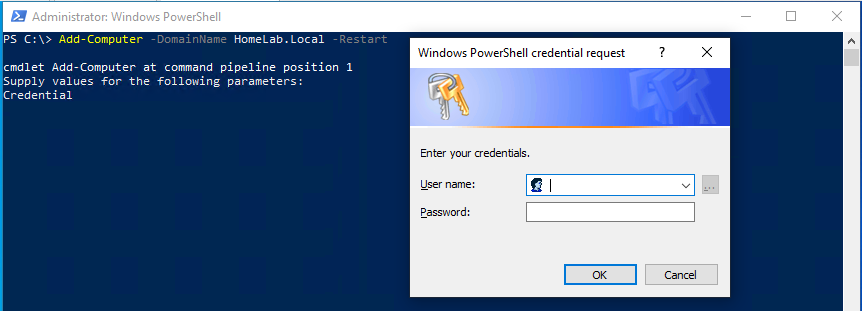
Add a Local Computer to a Domain Via WMI
To ensure this tutorial covers all ways you can add a computer to a domain, let’s continue with a lesser-known method of using Windows Management Instrumentation (WMI). WMI is a ubiquitous part of Windows that contains loads of information about a PC and can perform actions on it.
To add a local computer to a domain with WMI, you need to invoke a WMI method. This method performs the same task as using netdom or the Add-Computer PowerShell cmdlet.
You can invoke WMI methods in many different ways. For this tutorial, let’s focus on two ways using the *wmic* command-line utility and PowerShell.
Using WMIC
To add a computer to a domain with WMIC:
1. Open a command prompt (cmd.exe) as administrator.
2. Run the below command. This command:
- Specifies the local computer using a where query (
where name="%computername%") - Invoke the WMI method
joindomainorworkgroup(call joindomainorworkgroup) that’s a part of the Win32_ComputerSystem WMI class (computersystem) - Specifies appropriate bitwise operators to join the domain (
fjoin options 3) - Adds the computer to the homelab.local domain (
homelab.local) authenticating with the labadmin user account (username="homelab\labadmin Password="secret")
wmic computersystem where name="%computername%" call joindomainorworkgroup fjoinoptions=3 name="homelab.local" username="homelab\labadmin" Password="secret"Copy

3. When completed, restart the computer.
Using PowerShell’s Get-WmiObject Cmdlet
You can also invoke the JoinDomainOrWorkgroup WMI method using PowerShell. To do so:
1. Open PowerShell as administrator.
2. Run the following command. This command performs the same task as wmic does above using the same arguments.
(Get-WMIObject -NameSpace "Root\Cimv2" -Class "Win32_ComputerSystem").JoinDomainOrWorkgroup("homelab.local","secret","homelab\labadmin",$null,3)Copy
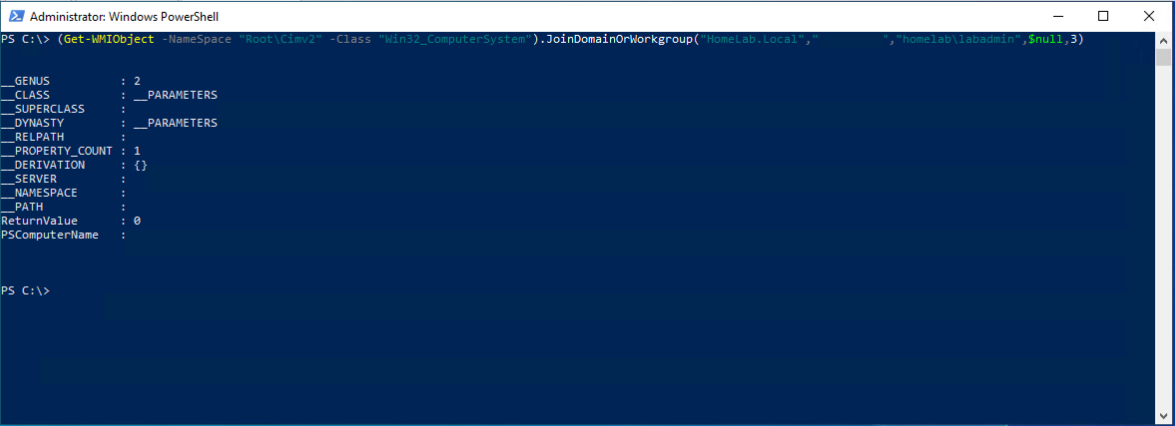
3. When completed, restart the computer.
Adding Computers Remotely to a Domain
Throughout this tutorial, you’ve learned how to add a computer to a domain as you’re sitting in front of that actual computer. But what happens when you can’t sit in front of that computer, or you have many computers to add? In that case, PowerShell is your best friend.
To add computers to a domain remotely, you could either choose to use the WMI method in PowerShell as describe above but use the ComputerName parameter on the Get-WmiObject cmdlet or use PSRemoting.
Related:PowerShell Remoting: The Ultimate Guide
To join remote computers to domain remotely, invoke the Add-Computer PowerShell cmdlet. But this time, use the ComputerName parameter.
To run the
Add-Computercmdlet remotely, you must ensure that PSRemoting is enabled on all remote computers.
1. On your local workstation (not the computer to add to a domain), open PowerShell as administrator.
2. Run the below command. This command:
- Adds the remote computer called win10demo (
-ComputerName win10demo) to the homelab.local domain (-DomainName homelab.local). - Uses the user01 local user on win10demo to authenticate to the remote computer (
-LocalCredential win10demo\user01) - Uses the labadmin domain account to authenticate to the domain to add the computer account (
-Credential homelab\labadmin). - Will restart the computer automatically after it completes (
-Restart)
Add-Computer -ComputerName win10demo -LocalCredential win10demo\user01 -DomainName homelab.local -Credential homelab\labadmin -RestartCopy
Once invoked, the Add-Computer cmdlet will then prompt you for passwords for the user01 and labadmin accounts. When complete, PowerShell will restart the remote computer automatically.
By default, the
Add-Computercmdlet will not restart the remote computer if a user is logged in. To override this, specify theForceswitch parameter to always to restart the remote computer.
Confirming Creation of the AD Computer Account
When a computer is added to a domain, it creates a computer object. To ensure the computer created the computer object as expected, let’s open Active Directory Users and Computers (ADUC) to confirm.
1. RDP to your domain controller and open Active Directory Users and Computers (ADUC) or open ADUC on your local computer if you have the Remote Server Administration Tools (RSAT) package installed.
Related:How to Install and Import the Active Directory Module
2. In ADUC, expand the domain name node (homelab.local in this case) and click on the Computers container. You should see the computer object added in the previous section.
By default, all computers that are added to a domain will be added under the Computers container.
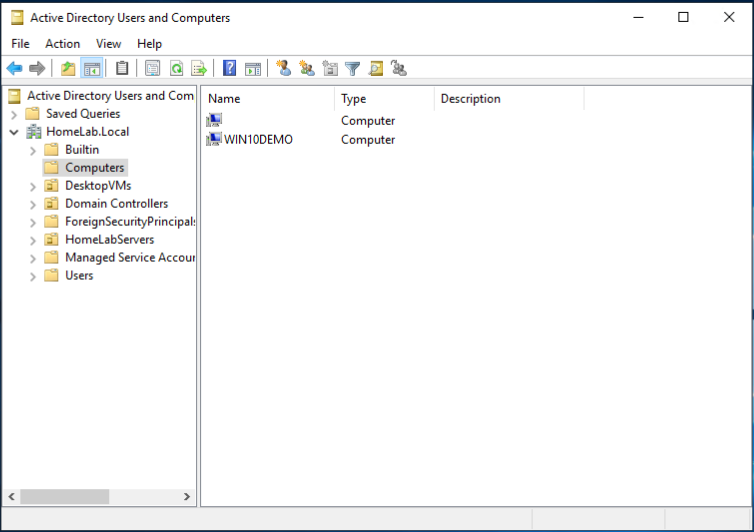
3. Back on the Windows 10 computer, now log on with any AD user account by clicking on Other User on the login screen.
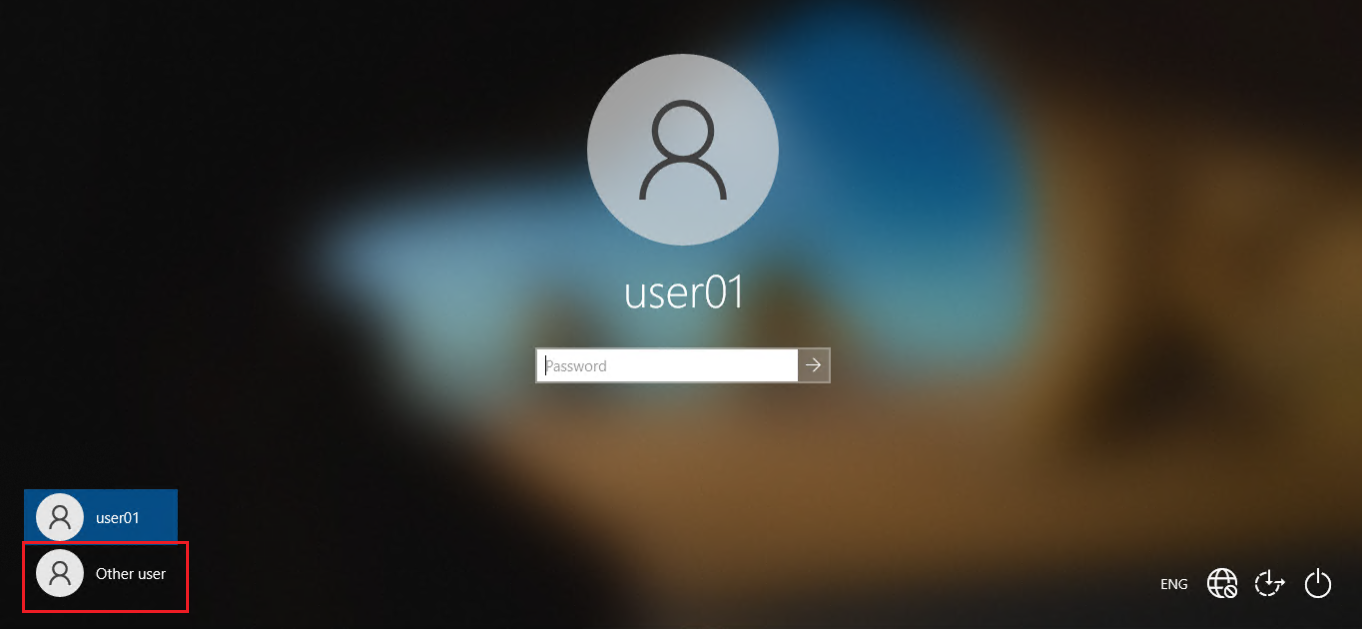
You can now see your domain name under the Password box as shown below.
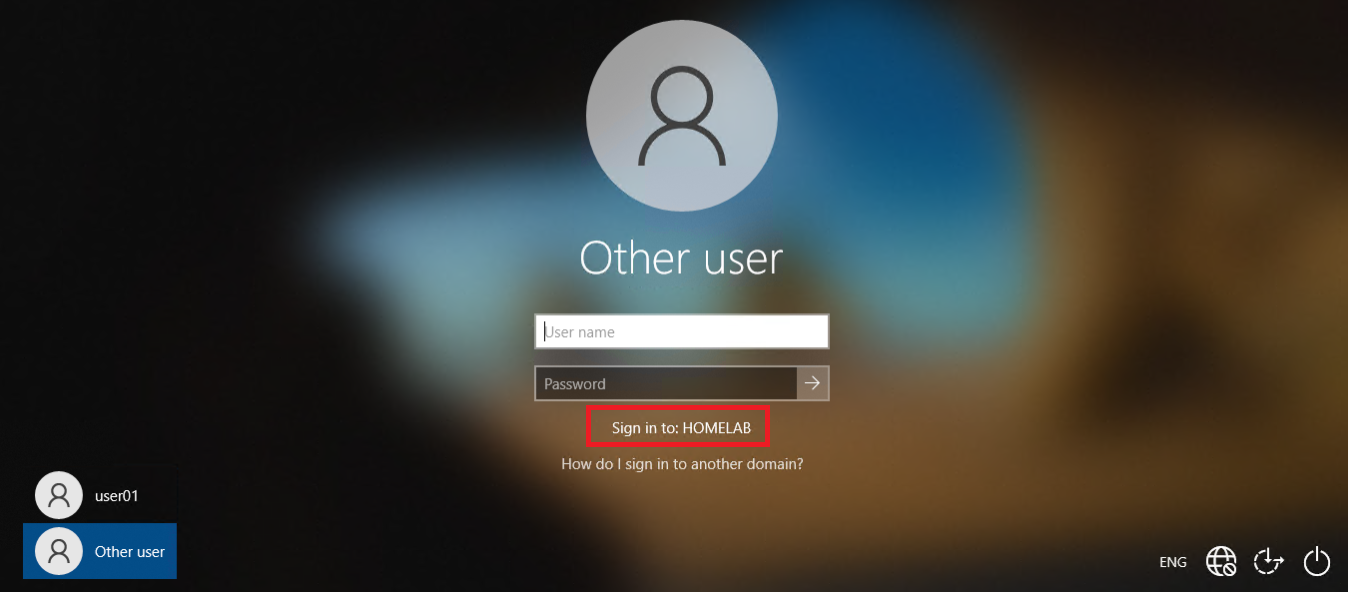
Do you have compromised passwords in your Active Directory? Find out with Specops Password Auditor Free.
Conclusion
Throughout this article, you’ve seen multiple ways to add computers to an AD domain. Each method has advantages and disadvantages, but you should now have all of the options in front of you.
Now that you know all of the ways to add a computer to a domain, how will you add your next computer to a domain?
